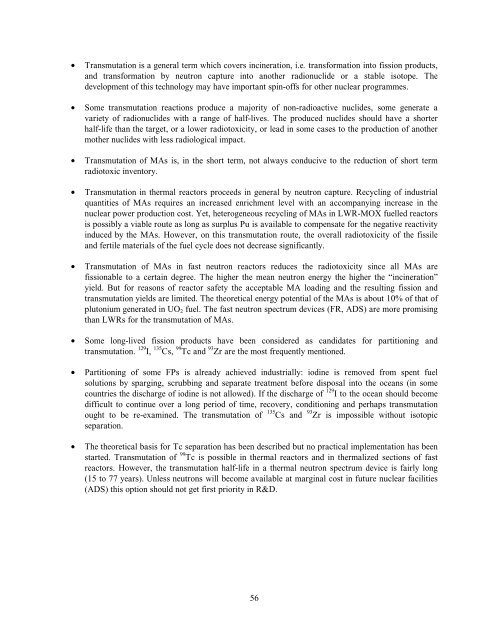COMPLETE DOCUMENT (1862 kb) - OECD Nuclear Energy Agency
COMPLETE DOCUMENT (1862 kb) - OECD Nuclear Energy Agency
COMPLETE DOCUMENT (1862 kb) - OECD Nuclear Energy Agency
You also want an ePaper? Increase the reach of your titles
YUMPU automatically turns print PDFs into web optimized ePapers that Google loves.
• Transmutation is a general term which covers incineration, i.e. transformation into fission products,<br />
and transformation by neutron capture into another radionuclide or a stable isotope. The<br />
development of this technology may have important spin-offs for other nuclear programmes.<br />
• Some transmutation reactions produce a majority of non-radioactive nuclides, some generate a<br />
variety of radionuclides with a range of half-lives. The produced nuclides should have a shorter<br />
half-life than the target, or a lower radiotoxicity, or lead in some cases to the production of another<br />
mother nuclides with less radiological impact.<br />
• Transmutation of MAs is, in the short term, not always conducive to the reduction of short term<br />
radiotoxic inventory.<br />
• Transmutation in thermal reactors proceeds in general by neutron capture. Recycling of industrial<br />
quantities of MAs requires an increased enrichment level with an accompanying increase in the<br />
nuclear power production cost. Yet, heterogeneous recycling of MAs in LWR-MOX fuelled reactors<br />
is possibly a viable route as long as surplus Pu is available to compensate for the negative reactivity<br />
induced by the MAs. However, on this transmutation route, the overall radiotoxicity of the fissile<br />
and fertile materials of the fuel cycle does not decrease significantly.<br />
• Transmutation of MAs in fast neutron reactors reduces the radiotoxicity since all MAs are<br />
fissionable to a certain degree. The higher the mean neutron energy the higher the “incineration”<br />
yield. But for reasons of reactor safety the acceptable MA loading and the resulting fission and<br />
transmutation yields are limited. The theoretical energy potential of the MAs is about 10% of that of<br />
plutonium generated in UO 2 fuel. The fast neutron spectrum devices (FR, ADS) are more promising<br />
than LWRs for the transmutation of MAs.<br />
• Some long-lived fission products have been considered as candidates for partitioning and<br />
transmutation. 129 I, 135 Cs, 99 Tc and 93 Zr are the most frequently mentioned.<br />
• Partitioning of some FPs is already achieved industrially: iodine is removed from spent fuel<br />
solutions by sparging, scrubbing and separate treatment before disposal into the oceans (in some<br />
countries the discharge of iodine is not allowed). If the discharge of 129 I to the ocean should become<br />
difficult to continue over a long period of time, recovery, conditioning and perhaps transmutation<br />
ought to be re-examined. The transmutation of 135 Cs and 93 Zr is impossible without isotopic<br />
separation.<br />
• The theoretical basis for Tc separation has been described but no practical implementation has been<br />
started. Transmutation of 99 Tc is possible in thermal reactors and in thermalized sections of fast<br />
reactors. However, the transmutation half-life in a thermal neutron spectrum device is fairly long<br />
(15 to 77 years). Unless neutrons will become available at marginal cost in future nuclear facilities<br />
(ADS) this option should not get first priority in R&D.<br />
56
















